UPDATE (04.02.2022): Removed a dead link.
Welcome to my ongoing NYTIP series! In this series of posts, I will expound on point 2 in my three-point plan to fix the NYC Subway – extend. I will begin by discussing Phase 2 of the Second Avenue Subway (SAS) and subway service to LaGuardia Airport.
Note: Click any image to enlarge.
I. SAS Phase 2
The current plan extends the Q train past its current 96th Street terminus to Lexington Avenue – 125th Street station, connecting to Metro-North and the 4, 5, and 6 trains. Curiously, the plan calls for tail tracks extending past Malcolm X Blvd – 125th Street station (2/3 trains), but no connecting station. The plan retains a provision for future service to The Bronx. Unfortunately, this phase isn’t scheduled to open until at least 2029!
Is a mere three stations the best we can do in a decade? Methinks not! Enter NYTIP.
The enhanced NYC subway under NYTIP increases Q service to 21 trains per hour (TPH) peak, effectively doubling SAS service. This would make the Broadway-SAS line competitive with the Lexington Avenue line, but extending the SAS beyond Lexington Avenue – 125th Street would make it even more competitive. I will call this extension SAS Phase 2X. Let’s explore the ways we can realize SAS Phase 2X.
Option 1a: Regional Plan Association (RPA) recommendation – Cross-Harlem and Concourse extensions
[Fig. 1] Overview of Option 1a. Source: RPA Save our Subways report.
The RPA’s Save our Subways report recommends two SAS Phase 2 extensions. SAS Phase 2B is the Cross-Harlem subway, while SAS Phase 2C is a proposed Bronx extension via Grand Concourse. In RPA’s plan, the T – a new line serving the full-length SAS – would serve the Cross-Harlem subway, while the Q serves the Grand Concourse. While this option has some benefits, there are also several issues. First, SAS Phase 3 is the earliest phase that would provide a southern terminus for the T. Secondly, interlining between Q and T trains would limit capacity on both. Finally, the Concourse connection would not lead to more service than that provided by the enhanced NYC subway; in fact, one station – 155th Street – 8th Avenue – ends up with less service. To address these issues, let us consider a similar alternative.
Option 1b: Cross-Harlem – Concourse connection
[Fig. 2] Overview of Option 1b.
Option 1b requires less new construction than Option 1a, albeit at the expense of a direct route from the Concourse line to the SAS. A key advantage of this option over Option 1a is doubled service on the Cross-Harlem subway at Lexington Avenue, Malcolm X Boulevard, and St. Nicholas Avenue, and increased service at 145th Street. Here, the A and C trains serve the Inwood line and the D and W trains serve the Concourse line. (The W designation is unused in v0.7.0 of the enhanced NYC subway, allowing its use for a potential SAS extension.) Seldom-used stub tracks between 145th Street and 125th Street on the Central Park West line would connect to the Cross-Harlem subway, as shown in the figures below.
[Fig. 3] Track connections between the SAS and the Concourse line. (Original track map by vanshnookenraggen.)
[Fig. 4] Overview of the CPW-SAS track connection.
Even without a Concourse-SAS service, these track connections allow operational flexibility. With these connections, SAS trains can access both the 207th Street and Concourse yards – an important consideration, given that these yards are potential maintenance facilities for SAS trains.
That said, if SAS Phase 2X serves The Bronx, is the Concourse line the best option? Let’s explore alternative Bronx extensions.
Option 2: 3rd Avenue subway
[Figs. 5, 6] Overview of Option 2.
Option 2 is the oft-discussed 3rd Avenue subway. It would replace the 3rd Avenue El, which MTA demolished in 1973. It would also close a large gap between the Concourse line and the southern portion of the White Plains Road line. The relatively high ridership of existing bus services – namely, the Bx15 and Bx41 – make the 3rd Avenue subway a strong contender. This option contemplates a subway to Fordham Plaza with provisions for extension further north.
The RPA once recommended the 3rd Avenue SAS branch. In recent years, however, RPA changed course and proposed SAS Phase 2C instead (see Option 1a above). RPA’s justification for this is their T-REX proposal, where regional rail service on Metro-North’s Harlem line serves the 3rd Avenue corridor. While I don’t think sending SAS via Concourse is the best option for The Bronx, regional rail has significant potential. I have some ideas that differ from RPA’s – as such, I will devote a future series of posts to regional rail under NYTIP.
Option 3: Morris Park subway
[Fig. 7] Overview of Option 3.
Option 3, like Option 2, begins with a 3rd Avenue subway serving 138th Street, The Hub – 149th Street, and 163rd Street. Rather than continuing north, the line takes a northeasterly route via Boston Road and Morris Park Avenue to Morris Park. This route would relieve the overcrowded 2 and 5 trains, and enable a future transit hub at Morris Park – the site of one of four new Metro-North stations comprising Penn Station Access (PSA). Although the FRA contemplated regional rail service at Morris Park (see section 3.7.6 of the linked document), it would be a local stop under PSA – I haven’t heard any plans for Amtrak service since. A new rail yard could be built near the Hutchinson River Parkway and I-95, northeast of the Morris Park terminal.
Option 4: South Bronx subway
[Fig. 8] Overview of Option 4.
Option 4 provides a subway connecting key hubs in the South Bronx – namely, The Hub and Hunts Point. This subway serves as a minimum operating segment for an extension to the East Bronx. There are four potential alignments for the East Bronx extension.
Option 4a: White Plains Road takeover
[Fig. 9] Overview of Option 4a.
Option 4a extends the South Bronx subway to East 180th Street, then via the White Plains Road el to Wakefield. The el, having been built under the Dual Contracts, is strong enough for the heavier SAS trains. However, its platforms require modification for wider trains. The 239th Street Yard would serve SAS trains, leaving the East 180th Street and Unionport yards for the 2 and 5 trains. Under Option 4a, the 2 gets truncated to East 180th Street, while the 5 serves the Dyre Avenue line; hence, the 2 would run local in The Bronx, while the 5 would run peak-directional express service.
Option 4b: Dyre Avenue takeover
[Fig. 10] Overview of Option 4b.
Option 4b extends the South Bronx subway to East 180th Street, then via the Dyre Avenue line to Eastchester – Dyre Avenue. The Dyre Avenue line, being a former railroad right-of-way, can accommodate larger SAS trains; this requires platform modifications for wider trains. The Unionport Yard would serve SAS trains, leaving the East 180th Street and 239th Street yards for the 2 and 5 trains. Under Option 4b, the 2 runs to Wakefield – 241st Street, while the 5 runs to Nereid Avenue during peak hours and to East 180th Street other times; hence, the 2 would run peak-directional express service and the 5 would run local in The Bronx.
Option 4c: Pelham line takeover
[Fig. 11] Overview of Option 4c.
Option 4c extends the South Bronx subway via the Pelham Line. The Pelham el is also capable of supporting larger SAS trains with platform modifications. To facilitate W service, the 6 would be truncated to Hunts Point Avenue. With Westchester Yard serving SAS trains, the 6 would need a new storage yard. (Alternatively, the 6 could extend to East 180th Street, providing access to the East 180th Street and Unionport yards.) As the W alone cannot replace frequent 6 service in its entirety, this option isn’t viable without additional investments.
Option 4d: Lafayette Avenue subway
[Fig. 12] Overview of Option 4d.
Option 4d is my take on the Lafayette Avenue subway – a plan dating back to 1939. It runs via 3rd Avenue, 163rd Street, Garrison Avenue, and Lafayette Avenue to Throggs Neck. The two terminal options are Locust Point – Edgewater Park (minimum-disruption option using a highway right-of-way), or Tremont and Harding Avenues (higher ridership potential, but possibly more disruptive). This option contemplates an elevated extension for most of its length due to two water crossings – Bronx River and Westchester Creek. The line could emerge on Garrison Avenue east of Bryant Avenue to avoid tunneling under both waterways; if this is infeasible, the line could emerge on the north side of Soundview Park west of Morrison Avenue. A storage and maintenance yard could be built near the Bruckner Interchange.
As of 01.31.2022, I am still leaning on the Cross-Harlem subway (RPA’s SAS Phase 2B – Q train extension) in the short term. As I mentioned above, the Cross-Harlem subway provides immediate relief by connecting to every subway line that currently serves The Bronx. This also makes the Concourse line a viable alternative to the oft-crowded 4 line.
There is one lingering issue, however. The City Hall reverse curve limits Q service to 21 TPH – about every 2 minutes 51 seconds. The high ridership of the four 125th Street stations on the Cross-Harlem line – to say nothing of the SAS proper – would likely warrant more than 21 TPH. A capital solution exists to this problem.
Potential capital investment: complete the City Hall lower level station.
Completing the partially-built City Hall lower level provides a place to short-turn Q trains without interfering with through service to Brooklyn. This would allow the Q to run up to 30 TPH peak (every 2 minutes) instead of 21. As such, SAS Phase 2X would include this investment.
Future Considerations
Building the Cross-Harlem subway does not preclude a future Bronx SAS branch, especially if the full-length SAS gets built. For many years, I’ve favored Option 2 for this branch. However, given the implications of regional rail, I’ve gradually shifted to a version of Option 4. In particular, the Lafayette Avenue subway in Option 4d would fill a gap in The Bronx served neither by existing subways nor future regional rail lines. On the other hand, the IRT takeover options afford an opportunity to de-interline the Bronx IRT without severing connections to Manhattan’s east side.
I will explore these options further in a future post.
II. LaGuardia Airport
LaGuardia Airport (LGA) is one the busiest airports in the United States, yet it has no direct rail link. It is widely criticized as a substandard airport in terms of flight delays, outdated facilities, hellish traffic, and its lack of rapid transit options.
The “Backwards” AirTrain
A few years back, former governor Andrew Cuomo unveiled an ambitious redevelopment plan for the airport, which included an AirTrain. However, this AirTrain was rife with problems, from its proposed routing away from Manhattan, to its $2 billion price tag, to its Flushing Bay alignment. Mind you, the project was initially slated to cost $450 million and was supposed to run over the Grand Central Parkway (GCP).
It’s clear we need something different.
The previous plan for an LGA rail link called for extending the Astoria El to the airport – a plan dating back to 1943! Previously, community opposition killed this plan whenever the City proposed it. More recently, the proposal appeared to die once again at the EIS phase of Cuomo’s LGA project – a phase transit advocates lambasted as “rigged”.
And I agree! However, former governor Cuomo’s grip on NY was so strong that it appeared the “backwards” LGA AirTrain was inevitable. I wrote a NYTIP INSIDER post discussing ways to improve the proposed LGA AirTrain.
However, two key events made the LGA AirTrain less “inevitable”. First, in February 2021, the Federal Aviation Administration (FAA) announced a rule change regarding mass transit connections to airports, effectively allows rapid transit services to serve airports directly. (Previously, so-called “passenger facility charges” could only be used for airport-specific improvements, such as airport circulators.)
Some time afterwards, the Guardians of Flushing Bay, an advocacy group, revealed just how rigged the so-called EIS process actually was:
Second, in August 2021, the once-untouchable Cuomo was forced to resign after an investigation by NY Attorney General Leticia James found that Cuomo sexually harassed multiple women. His replacement, Kathy Hochul, effectively put the brakes on the backwards AirTrain shortly after she assumed office.
The “Forwards” AirTrain…Isn’t An AirTrain At All
With the LGA AirTrain effectively dead, there’s been a renewed push to extend the Astoria El to LGA. While some politicos are proposing convoluted schemes like a divergence south of Astoria Boulevard, there’s only one alignment that makes the most sense.
Ironically, the way forward is in the rigged EIS – namely, Alternative 8B:
[Fig. 13] LGA subway extension options. Source: LGA FEIS – Alternatives.
Alternative 8B sends the extended Astoria El through the Con Edison property (which would include the storage yard in the enhanced NYC subway), then via 19th Avenue and the GCP to LGA.
As of 01.31.2022, I am still leaning toward a modified version of Alternative 8B. The modification is an infill station at 94th Street to serve East Elmhurst and LGA’s west side, as shown below:
[Fig. 14] Astoria El extension to LGA.

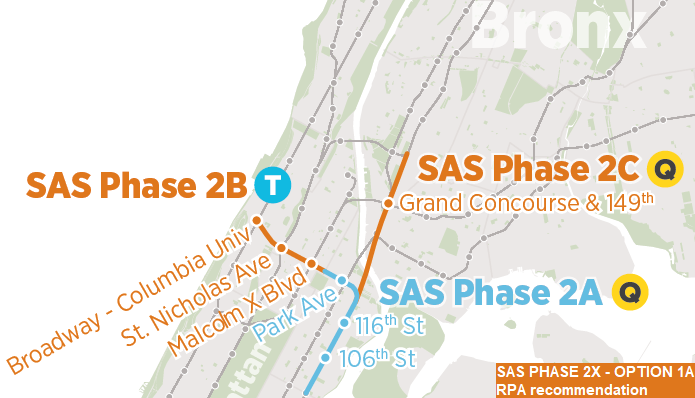
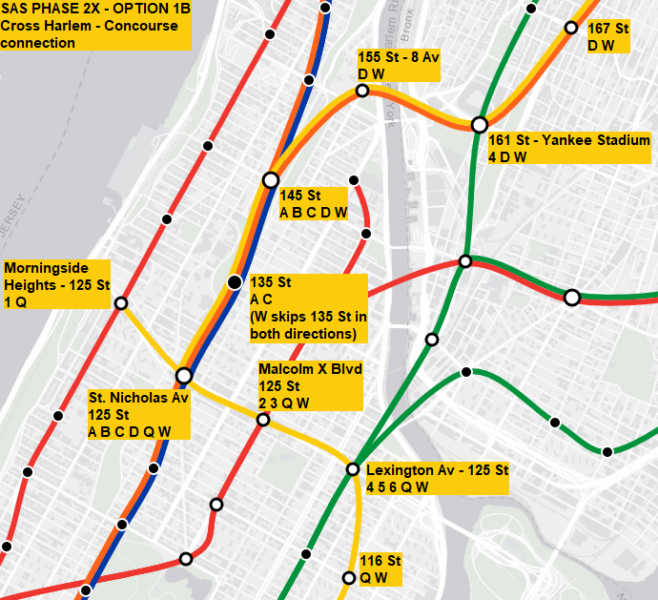

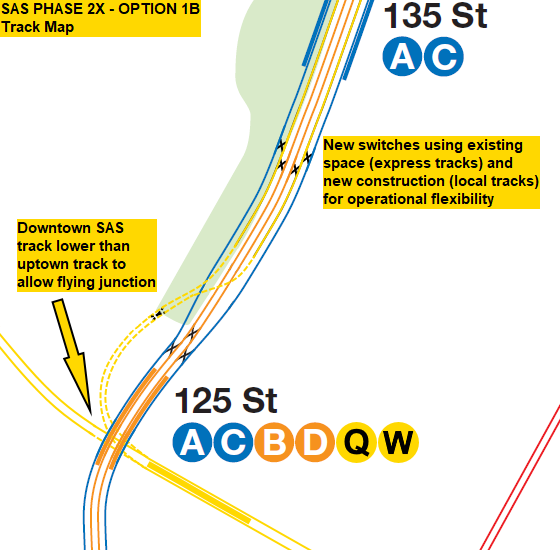
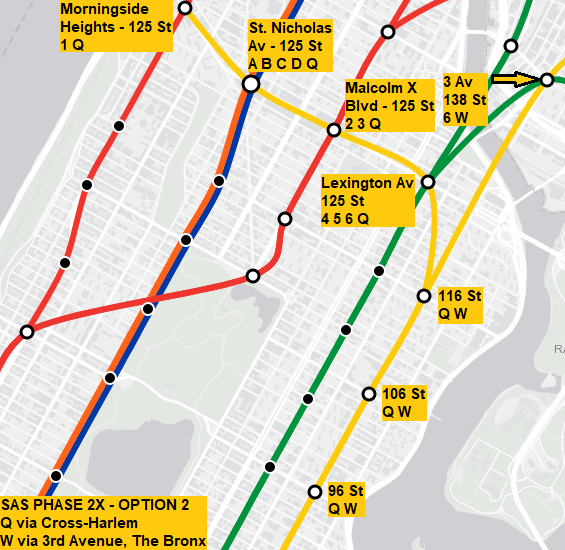
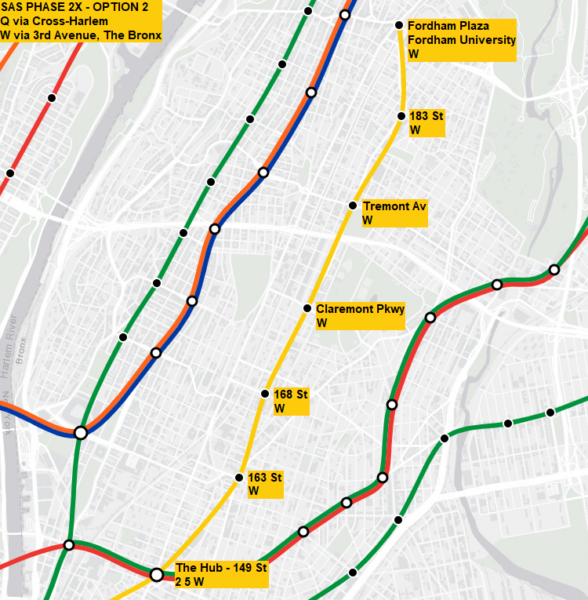
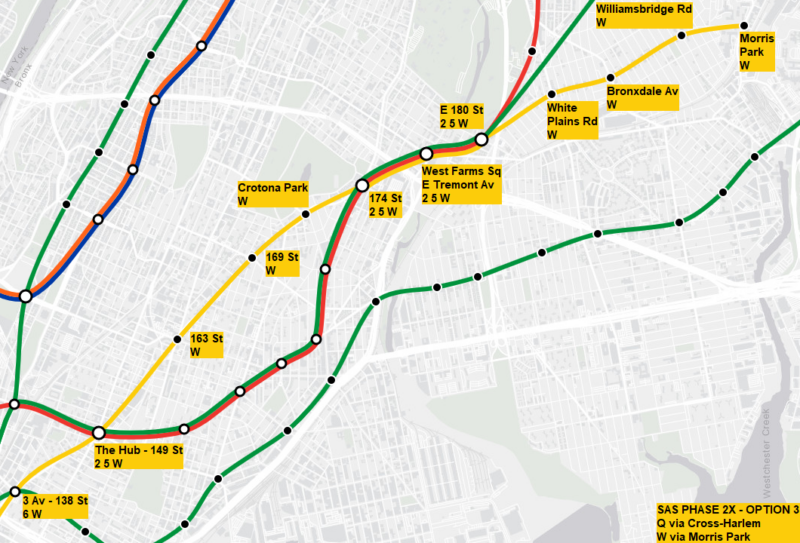
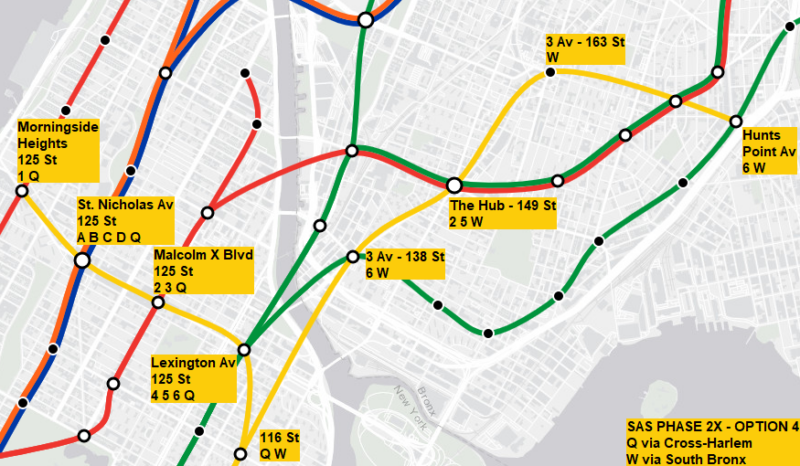
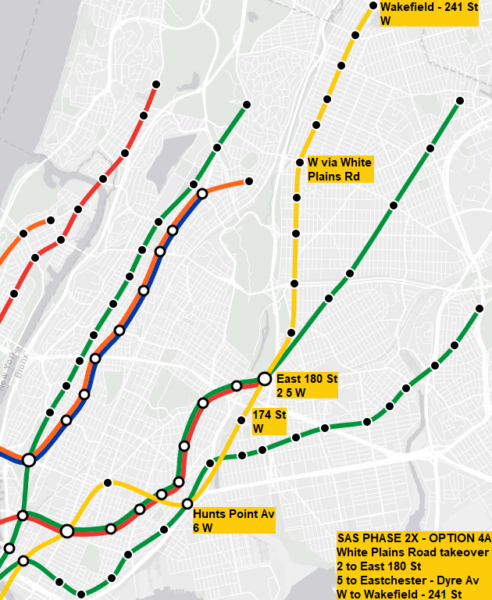
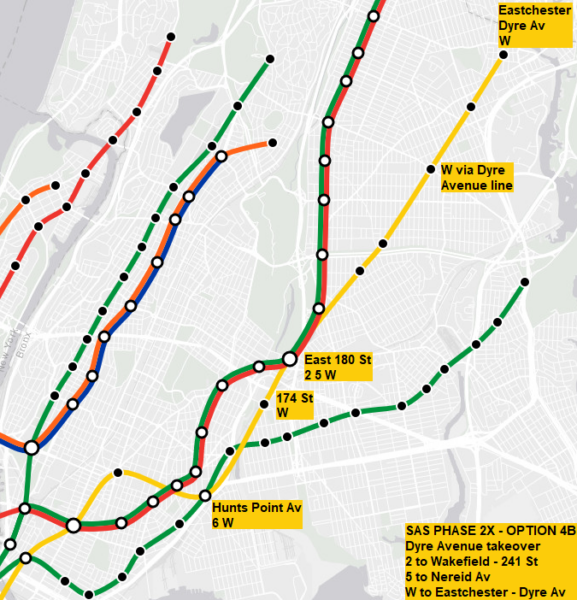
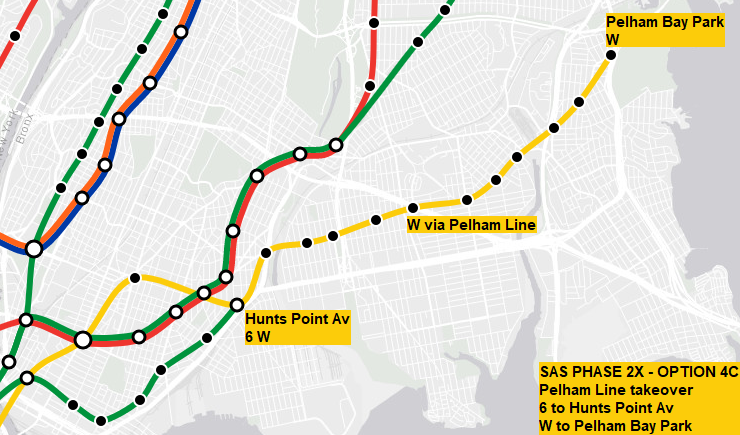
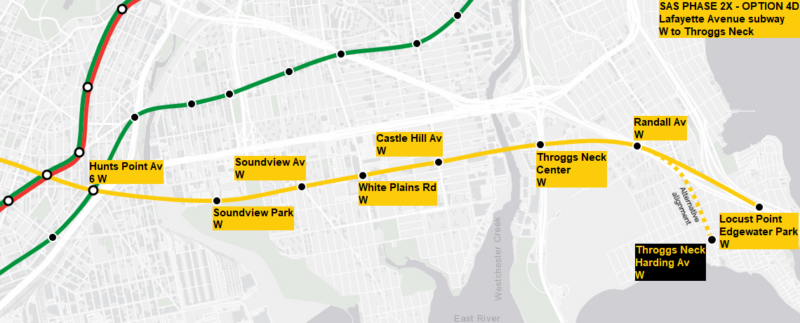
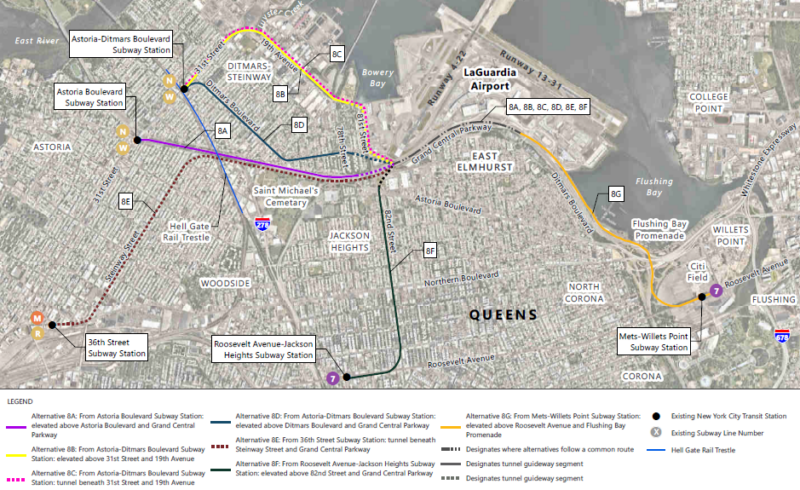
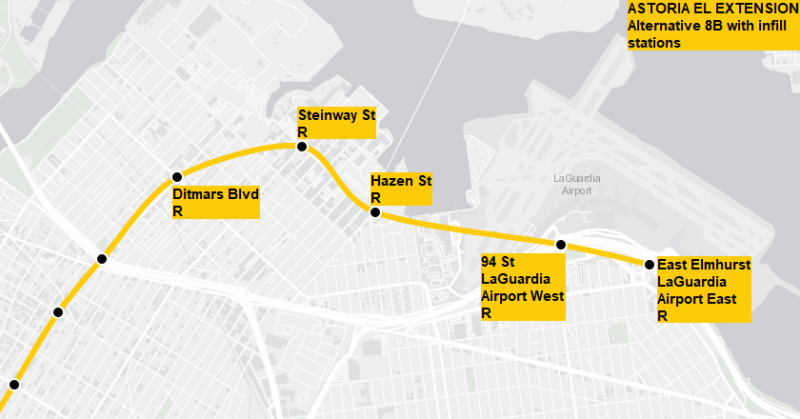
Option 3: Morris Park subway
As a former rider of the 2/5 lines they never appear to be over crowded (especially the #5). As a matter of fact, the #5 is the least crowded of the Bronx lines (especially the white plains road route). And the #2 often runs at less frequency than the #5 or other lines in the Bronx. So when the #2 becomes crowded, that’s because it is running a late schedule, which often happens on this line.
So, although I support more transit in the area, money should be allocated to lines that serve new area. And as you already mentioned, the metro north will soon serve this area. Besides, a Lafayette line is more than enough to serve this area without duplicating what is already there. And, doesn’t the #5 already serve the Morris Park area?
The Dyre Avenue branch of the 5 has a Morris Park station, but the purpose of my “Option 3” was to serve the Hutchinson Metro Center. When I first included this option, I assumed that regional rail would’ve remained a semi-premium service (i.e. higher fare). As I now firmly believe that regional rail within NYC limits should have the same fare as the subway, I agree with you that such a line isn’t necessary. If regional rail takes care of 3rd Avenue and the Morris Park corridor, then the path forward for a Bronx-SAS line is the Lafayette Avenue branch.
Option 2: 3rd Avenue subway figure 8.
This for me is the best option other than Lafayette Avenue as it provides new service. But I would extend it to at least the “D” possible #4 connection line. I don’t know how logical to extend it to the Metro North Hudson line because of the geography of the area..
It is completed redundant to extend it north on Webster Avenue since 1) The Metro North already serves this area (as well as the “D” (205th Street Stop) north of Fordham Plaza. and 2) there really isn’t a traffic flow to draw from. The only reason why (I think) the el extended that far is to connect with the white plain road yard. Remember, the line lost it Manhattan terminus in the mid 50’s including it yard.
Just get use to the names Fordham Plaza East (Webster Avenue) and Fordham Plaza West (Grand ConCourse and Jerome Avenue).
I think this is a win, win for passengers who want to travel north/south west from 3rd Avenue.
Option 4a: Lafayette Avenue subway:
Lafayette provides a south east route that only existed on paper. This new line would evenly distribute passengers currently using buses to the #6 line.
The other thing I like about your sketch is that the line will fix a redundancy; the #2 and #6 lines are at there closes point at Hunts Point Avenue and Simpson Street (one block). This line connects the dots while somewhat serving a new area. But in this case, I think the 3rd Avenue does it better minus the Lafayette route of course.
Since we are talking about the Bronx, I read that the Brooklyn/Queens and The Bronx want to introduce a service. You do know that anything run on Hells Gate must be a commuter service. So after some reading I came to the conclusion that it would run out of New Haven Connecticut. So there goes the idea of a Queen to/from subway line.
But wait!
2 blocks from Ditmars sits a Con Edison plant. I Invision the “N” eventually connecting to the Dyre Avenue line from there. But yes, extending it to LaGuardia makes much more immediate sense with a faction of the cost to build it.
The 3rd Avenue branch of SAS has always been one of my top choices. Only recently have I begun looking at regional rail as an alternative, since lower fares and infill stations on the Metro-North Harlem line could do the job. Even with regional rail, you have a gap in the SE Bronx, which is where the Lafayette Avenue SAS branch comes in.
If the “Brooklyn/Queens and The Bronx” service you’re alluding to is the Triboro RX, then I’m absolutely fine with it as a branch of the regional rail network – though I’d keep the Triboro entirely within city limits to avoid gumming up Shell Junction more than necessary.
Well as for the 3rd ave line I mostly copied stations from the older 3rd ave el maybe we could remove 156 st and move 163 st to 161 st. And a local-express service would be a boon to central Bronx and be the Bronx answer to the queens blvd line. But one main problem is where would we build a new train yard
Here’s a revised proposal of the K train route instead it would run via northern blvd line it would run up to Whitestone expressway then it will be connected to the 63rd st tunnel this train shall be known as the K train the station it will serve
Whitestone Expressway 112 st
104 st
Junction blvd
85 st
74 st
Broadway northern blvd
Sunnyside 39 st
21st st Queensbridge
Roosevelt Island
Oh and here’s a cheaper alternative to building the 21 st line if we had the N and R switch northern terminals I believe a 2nd ave subway should run there it could be named the W train 2nd ave express. It would run the same route as the K train I proposed earlier the only difference it would run via Astoria in queens. Maybe we can just postpone the 21 st line and use the money to build an Astoria extension to LaGuardia airport. I mean the plan have some flaws but it’s embarrassing that a single guy have a better plan then ENTIRE MTA STAFF COMBINED
No need to disparage MTA employees. Remember, the forces that drive NY transport are often political; this often kneecaps transformative change (case in point: Andy Byford).
Well how would you design the second ave line feel free to use my route labels or your own where do you think it should run.
Here’s a very rough draft of my long-term plan for SAS:
1) (N)/(Q): Broadway – SAS express: two express tracks built below existing SAS for N/Q; trains stop at 72nd and 116th before heading to The Bronx.
2) (T): SAS Local – this is the currently-planned line, plus extensions westward on 125th Street and eastward via Fulton Local in Brooklyn.
3) (U): SAS Express – this line runs from The Bronx to Brooklyn, most likely via 3rd Avenue (BX) and Utica Avenue (BK).
4) Queens – SAS line (routes TBD; most likely via SAS local on separate tracks).
Overall, the SAS trunk line will have 6 tracks in Manhattan, with the existing 2 tracks remaining as is for the T and 4 tracks built on the lower level. Details in future posts.
To me the SAS is the more UNBALANCED project the current plan is arguably the cheapest but the MTA will GREATY REGRET the design when ridership increases what I’m proposing will better serve the needs of the people but it would cost MUCH MORE money and take WAY LONGER needless to say the SAS is a great concept but with wasted potential
For the 3rd ave line I believe some parts should be elevated to run certain parts on Webster ave to co op city but depends on the community reaction
The 2 ave line is a great concept full with wasted potential as Vanshnookenraggen stated before it PAINFULLY OBVIOUS that the mta is just trying to build the cheapest subway but I have a plan it would include the currently proposed T train service a newly restored V train service and an additional third train route but for now I called it the K train Let’s start off with the Bronx
So remember how the 3rd ave line was demolished well while it was a reasonable decision it was a terrible mistake to leave 3rd ave without a replacement because it’s the largest population in the Bronx so trust me 3rd ave IS IN DIRE NEED OF A SUBWAY SYSTEM. So I propose having The T train start at White plains rd gun hill rd transfer to the 2 and 5 trains. Then it will go to Williams bridge Gun hill rd
meeting up with the V train. The T train will be the full time local the V train will be the weekday only express. Local service only stops
204 st
187th st
180st st
171st st Claremont pkwy
168th st
163rd st
156th st
Local and Express service stops
Bedford park blvd
Fordham plaza
Tremont Park 177th st
3 ave 149th st
3 ave 138th st
They both trains will run to Manhattan via the 3rd ave tunnel
Maybe we can build express train on the lower level
Both train meet up with the Q train
The V train runs express the T train runs local with the Q train
Local service only stops
116th st
106th st
86th st
Local and Express service stops
125th st
96th st
72nd st
Next let’s move on to queens
A new train line would be built via 21 st to LaGuardia airport then it will be connected to the 63rd st tunnel this train shall be known as the K train the station it will serve
LaGuardia Airport Terminal 94th st
82nd st
74th st
46th st
Steinway st
Astoria Blvd
30rd ave
Broadway
36th ave
21st st Queensbridge
Roosevelt Island
Now back to Manhattan
The K train meets up with the T and V trains at 57 st
K V express and T local
Local service only stops
50th st
St Vartan Park 34rd st
23rd st
8th st St Marks Place
Houston st
Local sand Express service stops
57th st
42nd st Tudor City
14th st
Grand st
Chatham Sq
Then the K V will run to Brooklyn via a new tunnel underneath the Brooklyn bridge
While the T train will run to lower Manhattan making these two stops
Seaport
Hanover Sq
It would also build with connections to the montage st tunnel to potentially be extended to Brooklyn via 4th ave
Back to Brooklyn the K and V would makes these stops Prospect st and then it would run underneath jay st metrotech while the culver express tracks would connected to them lower Bergen st would be rebuilt for express service the K V would run express the F G would run local
At church ave the V train would continue off to kings highway or maybe ave x running express while the F train remains local
Last but not least the K train would run via Fort Hamilton line the stations
38th st
44th st
51st st
62nd st
69th st Bay Ridge ave
Bay Ridge parkway 75th st
86th st
92nd st John J Carty Park
John Paul Jones Park 101st st
(T) 3rd Avenue/2nd Avenue Local
Rush Hours: 4th Avenue/West End Local
(T) Co op city blvd Bronx-Hanover Square Manhattan
Rush Hours: Bay Parkway Brooklyn: all other times take (T) to Grand st for (D) or take (T) to 72nd st for (Q) then take (Q) for 57 st 7 ave for (R) then take (R) to 36rd st for (D)
(T) operates all times 24/7
(V) 3rd Avenue/2nd Avenue/Culver Express
(V) wiallimsbrigde gun hill rd Bronx-Kings highway Brooklyn
(V) operates weekdays only Mondays-Fridays 6:30AM-10:15PM
During Weekends and Late Nights Take (T) to Houston St for the (F)
(K) LaGuardia Local/2nd Avenue/Culver Express/Fort Hamilton Local
(K) LaGuardia Terminal Queens-John Paul Jones Park 101st st Brooklyn
(K) operates all times 24/7
I gotta admit this will cost FAR MORE than the current proposed second ave subway but what I trying to say is that the current plan only helps people in the east side of Manhattan travel a bit better. It does practically NOTHING almost nothing for riders from The Bronx Queens or Brooklyn. I mean the biggest flaw is that there no express tracks HECK they isn’t even third track that could be used for emergencies. Meaning that if something goes wrong at one station THE ENTIRE LINE is screwed up. I mean at least make room for the express for when ridership increases they can be build easily. I’m concerned about the cost of course. But government please fund the mta Costs must be brought under control cost should not be an excuse to build a less effective subway line. Transit should be built where it’s most effective not where it’s cheapest to build.
To be honest the two track 2nd ave line was build back when ridership was lower but ridership have RAPIDLY INCREASED that’s why adding express tracks to the 2nd ave line is needed. If we building a new subway line why are simply building it to better serve the needs of the present. Let’s sit back and see what investments and expansions will be needed for the FUTURE. The 2nd ave line should be built to not just reduce crowding on the Lexington ave line but MANY OTHER TRAIN LINES ACROSS THE ENTIRE SYSTEM
Getting rid of the 3rd Avenue El in The Bronx is still one of MTA’s costliest mistakes in my book. The SAS *should* carry more than two tracks; however, with the existing SAS built as it is, I’d imagine any additional tracks would require a new lower level. Nothing that hasn’t been done before in the NYC Subway, but a consideration nonetheless.
On your plans, let’s just say I have different ideas for the full-length SAS and branches. I agree that some type of express service would increase the SAS trunk’s capacity. However, I think some of your proposed stations are spaced too closely. (I have different station locations in mind as well.)
I’m not sure I understand your Queens proposal. Are you suggesting a branch of SAS replace Broadway service on the existing Astoria line, or a new line via 21st Street? Either way, I’d say Northern Boulevard is a better corridor for a potential SAS-Queens line – either that or the Queens Super Express, depending on you approach de-interlining on Queens Boulevard.
As for a Fort Hamilton subway, I have mixed views on it. Could be useful if you extend it further to SI, though in that case I’d route the line via Owl’s Head Park as originally planned, as opposed to Fort Hamilton.
Well to be honest I figure that the 21 st line would reduce crowd on the Astoria and give riders a one seat rider to LaGuardia airport. And the fort haitmolin line would reduce crowding on the 4th ave line and I saw the proposion on a track map so why not see how it could coexist with the SAS
As for the extension to LaGuardia Airport, one line running with the R on Astoria could take over the Winfield Spur. It would fill in the unused terminal. Though, the wall that blocks the tunnel for the terminal would be demolished and will use the line for the line. It would go on what I used.
file:///Users/984613/Desktop/Screen%20Shot%202020-11-24%20at%209.46.21%20AM.png
Are you able to upload that photo to somewhere? The link is unusable as is (it’s a local link, so it’ll only work for you).
The SAS opened a few years ago. Though for the rest of the line, when it opens, the train going down to Hanover Sq will be the T train. Then it would go to Court Street and finish off the Fulton Street Line and replace the A over the line to Lefferts Blvd. I wonder whether the announcements would be the same as the others using R160s.
The SAS-Fulton connection is a no-brainer, though the official plans only bring the line to Hanover. Most likely scenario on Fulton is A/C express and SAS local, so assuming R160s, announcements will probably be similar to those of the C.
A quick separate word on train frequency. I assume 30 TPH as the ideal frequency to provide a train every 2 minute for a track with upgraded signaling and no interlining. But where it is not ideal, 24 TPH is probably a good working number. It assumes a train every 2.5 minutes plus, 24 is a very nice mathematical number as it is evenly divisible by 2, 3, and 4.
A 24 TPH can be split into two train services.
AB-AB, 50-50 split. Each line at 12 TPH or every 5 minutes.
If an uneven split is better, the following option are also workable:
AAB-AAB. A trains at 16TPH, B trains at 8 TPH. B trains every 7.5 minutes. A trains at 2.5 or 5 minute intervals.
AAAB-AAAB. A trains at 18 TPH, B trains at 6 TPH. B trains every 10 minutes. A trains at 2.5 or 5 minute intervals.
A 24 TPH can also be split into three train servcies
ABC-ABC. Even split. Each line at 8 TPH or every 7.5 minutes.
ABAC-ABAC. A trains at 12 TPH, every 5 minutes. B and C trains at 6 TPH or every 10 minutes.
ABABC-ABABC. If we assume 25 TPH, this allows for A and B trains at 10 TPH each and C trains at 5 TPH. A C train approximately every 12 minutes, and A and B trains at approximately every 5 minutes.
When dividing up a line into two or three branches, especially when deinterlined, there is no need to divide up the line evenly. I imagine that some of the services that split will be better to be split in an uneven fashion as above. For example, the three-way split of Fulton trains will probably be best as an ABABC pattern, rather than a ABC pattern. I imagine that Fulton locals to Euclid and Fulton expresses to Far Rockway have far more traffic than Fulton expresses to Lefferts. With only 3 unique stations, Lefferts trains can probably survive with half the service of Fulton expresses to FR. Local trains, though, should probably have about as many trains as the FR expresses.
Hi mrsman: sorry for the long delay in responding.
All of these ideas are interesting and worthy of consideration, but it’s important not to lose the plot here. The focus of NYTIP is to improve service in the most efficient manner possible – in general, simpler is better. There are certainly many possible ways to achieve this (and I still have a few more posts to update before continuing this series), but I’m not going to go over every possible iteration. In general, I pursue service patterns that minimize uneven splits. Fulton is an outlier for the reasons you mentioned – one branch (Rockaway) is much longer than the other (Lefferts). Here, I pursue the long game – have SAS take over the Fulton local, allowing A/C express (A to Rockaways, splitting between Far Rock and Rock Park – eliminating the shuttle – and C to Lefferts). Once you go uneven, you increase the chances of irregularity, which as you know ripples throughout the system.
For Culver, even pursuing the W4 swap, you still have to deal with the G (especially if you send two services through Rutgers). Clearly, one of the two Rutgers routes would go express in that scenario to minimize interlining, but you could also either truncate the G to Hoyt (not popular), or send it somewhere else (but again, that’s the long game); for now, the G mixes in like in the QB partial deinterlining option.
Hi mrsman:
I felt that part of our discussion here – mainly, how to de-interline Astoria and South Brooklyn in the absence of a new yard in Astoria – merited its own blog post, so here you go: https://nerdynel.me/2020/01/12/nytip103-5astsbk/
Regarding the 8 Ave locals as CPW locals to WTC: I see your point and it is true that WTC is a limiting factor. To actually get some hard numbers on the maximum ability to turn around trains would be extremely helpful.
I’m under the working assumption that the mid-section of a track, with proper signaling and perhaps a limitation on the use of timers, can run 30 TPH (every 2 minutes) easily. Most of the terminals can probably handle within the 15-20 TPH range, which means that the usual practice of sending two trains down the straightaway tracks, split into two separate terminals on either end works well [e.g. sending B and D down the 4 Av express in Brooklyn, but having only B to Sea Beach and D to West End.]
Three way splits are not ideal, but some already exist in the system. The trains in the Cranberry tunnel are already regularly split into C to Euclid, A to Lefferts, A to Far Rockaway, and even one or two A’s to Rockaway Park. [I really wish the MTA would use a different letter to distinguish the Rockway service from Lefferts service, especially that many tourists use the train to JFK. They shouldn’t get lost at Lefferts.] The Queens Blvd express does that too, although to be truthful there are only a handful of expresses to 179 and those are only utilized becuase of the 12 TPH limitation at Jamaica Center. That being said, it is possible that some of the Concourse locals can be service to an extent by 6 Ave expresses. FWIW, at least in Midtown there is no substantial difference between the 8th Ave express and the 8th Ave local, since if the E were to run express the only stations that are skipped by the express are 23rd and Spring. Again, my idea was to optimize the system ASAP [just a few months time to rework schedules and update maps] without the need for capital construction where there is no money.
Regarding the South Brooklyn trains:
Any option pushing the Broadway locals onto tracks other than the 4 Ave local would result in a protest by the local population. I felt that pushing the Broadway local to one of the Brighton trains would mean that there would still be the other Brighton train with access to the Manhattan Bridge. In my mind it seemed fairer than to push the only train on the Sea Beach or the West End to the Montague tunnel, but a similar type analysis could work there. If R trains (Astoria-Bwylocal-Montague tunnel) went to Sea Beach, there would be less intermixing, since all of the West End trains already split off earlier, but the switches at 4Av/59 probably can’t handle the heavy mixing. If R trains went to West End, they could take advantage of the flyover junction that is there at 4 Av/36, but the problem is [other than the protests from West End riders] that there are no switches south of the junction so that some of the 4 Ave expresses can serve the local 4 Ave stations south of 36th. If the B and D ran on the 4 Ave express, the D should continue to Sea Beach and the B should serve Bay Ridge, but to do that it should also serve the stations between 36 and 59, but it cannot without extra track switches. Regardless, nobody along Brighton, West End, or Sea Beach would be happy to trade their access to the Bridge for an R train through lower Manhattan, even if it ran express between Coney Island and DeKalb.
The only other option that may work would be an extension of a Nassau Street subway service to Bay Ridge. Prior to the cancellation of the V train, the M train during rush hours ran through the Montague tunnel to Bay Pkwy along the West End line. What if this service were recreated (and extended to more parts of the day, except late nights), but sending M trains to Bay Ridge and R trains to Bay Pkwy? [Or if the M’s stay on 6 Ave, extending J service to Bay Ridge.] To be conservative with the MTA’s resources, I imagine that this operation would only send 6 R’s and 6 M’s each hour through the tunnel. Most trains on either line will terminate somewhere in Lower Manhattan: City Hall and Whitehall for the R/W and Chambers and Broad for the J/M/Z. This would put 12 TPH (every 5 minutes) on the 4 Ave local north of 36 St and provide service to both sides of Lower Manhattan (granted Nassau and Church are not that far away from each other). The service to Bay Ridge would be somewhat paltry at 6 TPH, but it wouldn’t be crowded as most people along the corridor will switch to an express as soon as they could. Such a plan would separate 6 Ave and Bwy expresses at DeKalb, and only introduce a small amount of interlining at the Montague tunnel and at 36 St as R locals merge in with whatever express trains service the West End line.
Again, a yard in Astoria would solve all of these issues, but this seems like a viable interim measure, particularly as it would allow a majority of the system to operate more efficiently.
It is particularly sad that service to Bay Ridge was actually better when the Montague tunnel was closed due to Sandy repairs. This is because of the poor effects of interlining and the cascading delays that the R experinecing due to all the intermixing that it does, especially along Queens Blvd and the N switching from local to express at Herald Square. An M train to Bay Ridge would probably be as effective for Bay Ridge riders as the Brooklyn only shuttle, and it does provide a yard at the northern end of the line.
Had a few new ideas that may also bring some of this together. Consider:
$ Inwood/Conc exp – CPW exp – 8 Ave exp – Cranberry – Fulton lines – Ful loc to Euclid/ Ful exp to Leffert/ Ful exp to Far Rockaway [A, C, H trains]
[I think this was your idea, so not much to talk about. Current A train with some variants. Unified line from 145th to Hoyt/Schermerhor running at full capacity. Reasonable intermingling at 145th]
$ Jam Ctr/ FH to 179 loc/ FH to 179 exp – QB exp – 53 – 8 Ave loc – W4 swicheroo – (1/3 of trains terminating at 2 Av/Houston) – Rutgers tunnel – Culver line [E, blue V, blue K trains]
[Here, I’m deinterlining the M train away from 6 Ave. J/M/Z to stay on Nassau Street-Williamsburg Bridge and not interfere with any other lines. Terminate some trains at 2 Ave to allow for room for the G train to come in. Some intermingling with G train, but no intermingling with other trunk lines. This means that Rutgers tunnel is only operating at 2/3 capacity, but the QB/8th Ave segment north of 2 Ave/Houston to Forest Hills running at full capacity. There is a possibility that some Culver trains will terminate at Kings Hwy and that there will be room for some Culver expresses, but that is not a priority for me. The point is that since all trains stay on IND tracks, they can be run full-lenth.]
$ Forest Hills – QB loc – 63 St – 6 Ave loc – W4 switcheroo – WTC [F train]
[Full-length trains to service this segment, but limited to WTC’s terminal capacity. The difference in capacity between FH and WTC to be addressed by some G trains that will interline along the QB loc. Some intermingling with G train, but no intermingling with other trunk lines. By my estimation, it means that 63 tunnel and 6 Ave local operate at 16 TPH.]
$ W Hts/Conc loc – CPW loc – 6 Ave exp – M Br N – Brighton local / 4 Ave local to Bay Ridge [B, D train]
[As discussed in earlier comment, De Kalb intermingling with Bwy locals in order to provide Bay Ridge with access to Concourse yard. Also reasonable intermingling at 145th. And some intermingling at 4 Av/36 st in Brooklyn, see below. I address your concern about providing enough CPW loc service by briging the CPW locals to Brooklyn and not terminating at WTC. ]
$ Upper 2 Ave – Bwy exp – M Br S – 4 Ave express – Sea Beach / West End [N, Q train]
[This line is fully de-interlined, except with some intermingling at 4 Av/36 St in Brooklyn, see below.]
$ Astoria – 60 St – Bwy loc – Montague tunnel – Brighton exp / 4 Ave local to West End [R, W train]
[De Kalb interingling with 6 Ave express trains. Some intermingling at 4 Av/36 St in Brooklyn.]
A slight variation from my earlier comment addressing bringing 6 Ave trains to Bay Ridge. Instead of terminating all W trains at Whiethall, what if we brought them some through the Montague tunnel to provide additional service through the tunnel.
We are recreating the old pattern of intermingling at 4 Ave/ 36 St where one 4 Ave local goes to Bay Ridge, one 4 Ave express goes to Sea Beach, and a local and express both service West End, with one train going to Bay Pkwy and one train going to CI. IMO, ideally we can also provide some express service on the West End line itself. Intermingling is never ideal, but sometimes necessary to provide more access to different locations, and just as done at 145th street, provide as many people with access to the Bridge and Manhattan expresses. There is still a lot less interlining than current service. The intermingling in this case does allow for West End express service that could speed up a lot of southern Brooklyn trips to Midtown.
B trains servicing Brighton local. Every Brighton line station has direct access to the Bridge and an express train to Midtown via 6 Ave. Access to Upper Manhattan and CI yards. Transfer to R at any Brighton express station for access to Lower Manhattan. Transfer to 6 train at Bwy/Lafayette for access to any area btwn City Hall, Canal Street, and Union Square in lieu of access to Bwy express trains. [A free transfer to Prince St BMT would also help for access to eastern Manhattan below 23rd Street.]
D trains servicing Bay Ridge. Every 4 Ave station has direct access to the Bridge and an express train to Midtown via 6 Ave. Access to Concourse Yards. Transfer to R at DeKalb or W at any station from 36 St north for access to Lower Manhattan. Transfer to N,Q trains at any 4 Ave express station for access to Bwy express.
N trains servicing Sea Beach. Every Sea Beach staion has direct access to the Bridge and an express train to Midtown via Broadway. Access to CI yards. Cross-platform transfer at Barclay’s to D trains to 6 Ave. Cross-platform transfer at Barclay’s to W trains to Lower Manhattan or backtrack with a transfer at Canal Street to R/W, 6 , or J/Z.
Q trains servicing West End express. Q trains should start at Bay Pkwy and provide express service on the West End line to further speed up trips in southern Brooklyn. Most West End stations will not have direct service to the Bridge, but for those at the sourthern end of the line, the access to the express will save them time. Passengers on the Q train boarding at a West End express station will have direct access to the Bridge and an express train to Midtown via Broadway. Access to CI yards. Cross-platform transfer at Barclay’s to D trains to 6 Ave. Cross-platform transfer at Barclay’s to W trains to Lower Manhattan or backtrack with a transfer at Canal Street to R/W, 6 , or J/Z.
R trains servicing Brighton express. This is to be marketed as an express train to the Financial District, the only one servicing southern Brooklyn. Transfer from B to R train to get quickly to De Kalb, Downtown Brooklyn, and Lower Manhattan. Transfer to B/D at DeKalb for express service to Midtown via 6 Ave. Transfer to B/D trains at De Kalb and transfer again at Bwy/Lafayette for 6 train access to eastern Manhattan below 23rd street in lieu of Bwy express trains. Access to CI yards.
W trains servicing West End locals. While most West End stations will no longer have direct access to the Bridge, their overall trip is made quicker with the ability to transfer to Q trains at the Bay Pkwy, 62nd, and 9 Ave. For passengers on the W trains, a transfer to the Q will provide direct direct access to the bridge and a Broadway express. Transfers at any 4 Ave station to the D train to access 6 Ave express service. W trains provide access to Downtown Brooklyn and Lower Manhattan. Access to CI yard.
A lot of related discussion of this can be found on this thread:
https://www.reddit.com/r/nycrail/comments/c9c4j7/how_to_increase_broadway_local_service_without/
My apologies, the last comment didn’t forward well with formatting, hopefully this will work:
Without a yard to service Astoria-Bay Ridge line, the full deinterlining that I suggested in my last comment would not work. Every service other than the 6 Ave expresses, Broadway expresses, and Broadway locals can run as mentioned above. If there is no yard, there are 5 main options in routing the services through DeKalb to South Brooklyn.
For all options, B and D are CPW-6 Ave expresses (and thus have access to yards in Northern Manhattan and/or Bronx); N and Q are Broadway expresses; and R and W are Broadway locals. W trains will all go from Astoria to Whitehall, although to the extent that R trains also originate from Astoria in most of the options, a W may not be necessary, as it can be labeled as a short-run R.
OPTION 1 (EXISTING)
B Brighton exp
D West End
N Astoria-Bwy exp-Sea Beach
Q 2 Ave – Bwy exp – Brighton local
R Qns loc 60 – Bwy loc – Bay Ridge
W Ast – Bwy loc – Whitehall
Everyone knows this is horrible as N trains are forced to switch between locals and express. Plus there is a mess at DeKalb.
Trains serving DeKalb: B,Q,R
Trains serving the 4 Ave/Pacific platform at Atlantic (cross-platform): D, N, R
OPTION 2 (SUGGESTED BY A COMMENTER ON REDDIT)
B Brighton exp
D W End [or Sea Bch]
N Qns loc 63-Bwy exp-Bay Ridge
Q 2 Ave – Bwy exp – Sea Bch [or W End]
R Ast- Bwy loc – Brighton loc
W Ast – Bwy loc – Whitehall
As with the other options presented here, the solution to the yard problem is to send the Astoria-Bwy locals to
either Whitehall or the Brighton local. The idea is that every branch to Coney Island (WE, SB, Brighton) will still have at least one train leading to the Manhattan Bridge. Send the Astoria-Bwy local-Tunnel trains through as Brighton locals to access CI yard. Thus, Bay Ridge trains along the 4 Ave local will have access to either the 6 Ave expresses (yards in Northern Manhattan/Bronx) or the Broadway expresses (with access to Queens Blvd). Of course, to the extent that Queens Blvd connects to Broadway there is interlining. All of the options also involve some level of interlining at De Kalb.
This and all other options presented prevent Bwy locals and Bwy expresses from interfering with each other in Manhattan. That is probably the most critical thing that the MTA should do in the short term.
Trains serving DeKalb: B,R, N
Trains serving the 4 Ave/Pacific platform at Atlantic (cross-platform): D, Q, N
One negative with this and the other options is that the W End and Sea Bch will have to make two cross-platform transfers (Atlantic and DeKalb) to reach the R train for access to Lower Manhattan.
OPTION 3
Option 3 is like Option 2, except we isolate the 6 Ave trains from interference at De Kalb. Bwy locals and Bwy expresses still interline at De Kalb.
B W End
D Sea Bch
N Qns loc 63-Bwy exp-Bay Ridge
Q 2 Ave – Bwy exp – Brighton exp
R Ast- Bwy loc – Brighton loc
W Ast – Bwy loc – Whitehall
Trains serving DeKalb: Q,R, N
Trains serving the 4 Ave/Pacific platform at Atlantic (cross-platform): B, D, N
Sea Beach and West End passengers have direct access to 6 Ave express and a cross-platform access at Atlantic to the Broadway express.
OPTION 4
Option 4 is like Option 2, except we send the Bay Ridge trains to 6 Ave instead of the Bwy express. This will allow us to separate Queens Blvd from the Broadway trains.
B Bay Ridge
D W End [or Sea Bch]
N 2 Ave -Bwy exp-Sea Bch [or W End]
Q 2 Ave – Bwy exp – Brighton exp
R Ast- Bwy loc – Brighton loc
W Ast – Bwy loc – Whitehall
Trains serving DeKalb: Q,R, B
Trains serving the 4 Ave/Pacific platform at Atlantic (cross-platform): D, N, B
OPTION 5 (My preference)
Option 3 is like Option 4, except we isolate the Bwy exp trains from interference at De Kalb. Bwy locals and 6 Ave expresses still interline at De Kalb.
B Bay Ridge
D Brighton exp
N 2 Ave – Bwy exp – Sea Bch
Q 2 Ave – Bwy exp – W End
R Ast- Bwy loc – Brighton loc
W Ast – Bwy loc – Whitehall
Trains serving DeKalb: D,R, B
Trains serving the 4 Ave/Pacific platform at Atlantic (cross-platform): N, Q, B
Sea Beach and West End passengers have direct access to Bwy express and a cross-platform access at Atlantic to the 6 Ave express.
This option is my preference as it isolates Bwy express and keep Qns Blvd away from Bwy. 6 Ave expresses still interline with Bwy locals to provide two trains to Brighton and one train to Bay Ridge so that all trains have access to some yard. (The interlining is no worse than what we currently experience at DeKalb.)
These are options that can be implemented without capital expenditure. Of course, the best option, if there was a yard in Asotria, is to send the Bay Ridge trains to Astoria and thus fully deinterline DeKalb.
I saw that you revised your comment to fix the formatting, so I went ahead and deleted the duplicate comment with the bad formatting.
Obviously, the status quo that ties things up at the Gold Street interlocking has to change. Interestingly, for Options 2 through 5, you could run the R via Brighton express if you wanted to without affecting yard access. I’d imagine that, if most Brighton riders prefer Broadway service as they did when the Manny B reopened in 2004, this might not be the best option. But it is an option nonetheless.
Options 2 and 4 retain the Gold Street knot and are hence undesirable. Options 3 and 5 work better. To make them even simpler, you don’t need to swap the B and the D under either of those. For Option 3, you could still have D via West End (the B would serve Sea Beach); for Option 5, the B could remain as the Brighton express and the D could serve Bay Ridge. I agree that, absent the Astoria yard, some form of Option 5 would be best as this does not preclude a full Queens Blvd de-interlining. Also, whatever serves Bay Ridge under Option 5 does not conflict with Broadway thanks to the switch layout s/o DeKalb, making it preferable to the jumbled mess we have now.
I have thought of other deinterlining ideas that may account for trains better. The idea is to find what works with minimal capital investment. To work best, there still has to be yard access for the Astoria line.
Upper 2 Ave – 2 Ave – Broadway Express – Man Br S – 4 Ave express to West End/Sea Beach
Broadway express is completely deinterlined.
Astoria – 60 St – Broadway local – Montague Tunnel – Bay Ridge [a new Astoria yard required]
Broadway local is completely deinterlined.
Inwood/Bronx – CPW express– 6 Ave Express – Man Br N – Brighton lines
6 Av express is completely deinterlined.
QB local – 63 St – 6 Ave local – Rutgers tunnel – Culver Line or Myrtle Ave line
6 Ave local, north of Broadway-Lafayette is deinterlined. South of there, it runs the existing service of the F and M trains. F will interact with G. M will interact with J. So while the 6 Ave locals interact with other trains, there will be no interaction with any other trunk lines (Broadway ex/local, 8th Ave ex/local, 6th Ave ex).
QB express – 53 St – 8 Ave Express – Cranberry Tunnel – Fulton line
W Hts/Bronx- CPW local – 8 Ave local – WTC
The above can work, but it’s a little out of the box. Switches do allow for 53rd st trains to be 8th Ave express, (and all 8th Ave trains can serve 50 St). Both Queens express and Fulton are very heavy trains so their frequencies do match up. (Plus, each service serves three possible terminals: Fulton trains service Fulton locals to Euclid, Fulton expresses to Lefferts, and Fulton expresses to Far Rockaway; QB expresses service QB express to FH-local to 179, QB express to 179, and QB express to Jamaica Center.)
It is a very long routing, but the routing avoids the WTC terminal for Queens trains.
WTC is not a problem for CPW locals as those have a far lower demand than Queens.
And the trains sort of fit like a process of elimination. If Queens express go to 8th Ave express, then CPW locals must service the 8th Ave local. Then, the CPW expresses must service 6th Ave express, and the Queens locals must service the 6th Ave locals.
So long as Astoria-Bay Ridge is served by a yard, it seems like we have a significant deinterlining system wide. – without capital expenditure other than the yard. Plus, all Queens Blvd trains service Manhattan (no G train) without impacting Broadway.
I hope to address the problem with deinterlining if we don’t get a yard for Astoria tomorrow.
For the CPW de-interlining, you certainly could choose 6th Avenue express and 8th Avenue local, which would replace the C/D swap I proposed with an A/B swap. Although QB and Fulton have heavier demand than the CPW local, the WTC terminus is still a limiting factor for the total number of trains you can run. Consequently, if you split A/C service between Washington Heights and The Bronx, each would be infrequent even during rush hours. I don’t know the maximum TPH limit for WTC, but I don’t think it’s higher than 20 TPH – and it may be lower. Thus, this pattern limits service at the local stops in Washington Heights and the Concourse to an absolute maximum of 10 TPH peak. You’d still need some form of relief (e.g. stub tracks using the Worth Street subway provision, or the Worth Street subway itself, or that Spring Street connector) to allow further service increases.
Streamlining the Lefferts/Rockaway split the way you propose here is an interesting idea. While your proposed routes are long, express service offsets the length. Consider that once upon a time, the MTA operated the rush-hour C local from Bedford Park to Rockaway Park! Also, the E used to be an 8th Avenue express train via Fulton Street decades ago.
This is a good plan for a northern extension of 2 Ave. Curious to see if a southern extension of 2 Ave can work. By my estimation, it would be hard to fit in a 2 Ave south of 63rd street and still maintain good deinterlining.*
Of course if there are two separate northern terminals for 2 Ave trains (125/Broadway and Fordham Plaza), this would mean that all of the trains of the Broadway BMT express must go to 2 Ave (as you show) and there is no room to divert any Broadway BMT expresses to Queens Blvd (as I suggested in a comment to address Queens Blvd crowding that would not be successfully diverted to the G train). This would mean then diverting some of the Broadway BMT locals onto Queens Blvd instead of Astoria (which will not be possible if the Astoria service is more popular with LGA service) or biting the bullet and making capital improvements to the 8th Ave local southern terminal so that all Queens Blvd service can reach Manhattan without utilizing the Broadway BMT at all. [You had suggested a Worth Street subway, others have suggested perhaps a Spring Street subway to divert some 8 Ave trains onto the Williamsburg Bridge – that will also have the effect of allowing more 6 Ave trains to service the Rutgers tunnel and Culver line. Regardless, all of these tunnels are significant captial expenses that must be done, even prior to any extension of 2 Ave to two separate northern terminals.]
In that case, yes, all Broadway expresses to 2 Ave. All Broadway locals to Astoria and LGA. All Queens Blvd trains to utilize the 53 and 63 tunnels to service 8 Ave and 6 Ave respectively.
* One idea is that Q goes from Broadway to upper 2 Ave. N goes from Broadway to 63rd street to Queens. T goes all the way on 2 Ave. V goes from 2 Ave to 63 street to Queens. Not deinterlined, but service to many locations is maintained. It does mean, though, that there will be less service to the 8 Ave local and 6 Ave local as both of those will be serviced through the 53 st tunnel. So if this were a long range plan, there is no need to address the capacity at WTC along 8 Ave.
I’m curious about the Spring Street alignment. I know there was discussion on Twitter about splitting the J and hooking SAS to Williamsburg (though I don’t think it’s the same plan as the one you mentioned).
For SAS under NYTIP, what I’m thinking is having the full-length SAS run express north of 63rd Street on separate tunnels. This ensures no conflicts with the Broadway services that run local. This also does not preclude an SAS-Queens connection; if the mainline SAS operates express along its length, the SAS-Queens services could run via SAS local, maximizing capacity. This is all subject to change of course, but that’s where I’m leaning.
Can’t find it now, but there was a map where someone essentially drew a connecor along Spring Street from 6 Ave to Chinatown. The idea is that it will provide a second terminal for 8 Ave trains and allow for full service along the 8 Ave line and it will connect to the willy bridge line a little west of the Bowery station. Not an official plan by any means.
Ideally, a deinterlining plan can work to an extent because there are 6 northern portals, 6 central lines, and 6 southern portals. They are not currently all connected in the best way, but a few key connections could work:
Upper 2 Ave – 2 Ave – Broadway Express – Man Br S – Brighton
Astoria – 60 St – Broadway local – Montague Tunnel – Bay Ridge
W Hts/Bronx – CPW local – 6 Ave Express – Man Br N – 4 Ave Express to Sea Bch/W. End lines
QB local – 63 St – 6 Ave local – Rutgers tunnel – Culver Line*
Inwood/Bronx – CPW express – 8 Ave Express – Cranberry Tunnel – Fulton line
QB express – 53 St – 8 Ave local – NEW – Will. Bridge – Myrtle/Jamaica*
For something like this to work, there are several things that are needed. Yard access for the Astoria line. Something to address the way that G interlines with the F in Brooklyn so that G will no longer interfere with the F. A subway connection along Spring Street from the 8 Ave line to the Williamsburg Bridge. Maybe some work on the ramps near the W4 St station that allow 6 Ave trains to head towards WTC and 8 Ave trains to head east on Houston St – something i refer to as the w4 switcheroo. Perhaps making the 36 St station on QB line an express stop. New in-system transfers 59/Lex to 63/Lex, Prince to Bwy-Lafayette, Q plaza to QB Plaza, 53/7 Ave to 57/7 Ave
* QB is the hardest to deinterline even with dedicated access to the 53 and 63 stations. With the placement of the 11 St cut as access to the local lines, it is best to have the QB locals use 63. It is also true that 53 is a busier part of midtown, so it needs express trains. The problem is that the stations east of the Willl Bridge cannot take the longer trains, so we want to get the QB locals on the Will Bridge and the QB expresses onto the Culver line. This means using the W4 switcheroo. In that scenario:
QB express – 53 St – 8 Ave local – W4 switcheroo – Rutgers tunnel- Culver line
QB local – 63 St – 6 Ave local – W4 switcheroo – WTC (if no construction, so limited nubmer of trains)
OR Will Bridge (limited size of trains due to old stations)
Thinking about this more, that Spring Street connector and W4 switcheroo might work better than Worth Street. The reason why I didn’t consider W4 initially is because the Chrystie connector diverges east of B’way-Lafayette, creating a new conflict there. A Spring Street connector avoids this problem by preserving connectivity to Williamsburg; running 8th Ave service via Rutgers/Culver avoids the WTC issue.
So you could have a modified version of my QB Option 3 long-term, except the E/K take B-Laf and Culver, while the F takes WTC (shortening its route and eliminating the super-long-local issue) and the M takes Spring-Willy B, preserving its route in Brooklyn.
The opportunity cost of the Spring Street connector is fixing limitations on J/M service imposed by the capacity-killing at-grade merge at Myrtle. One thought I had long-term was rerouting the M via a rebuilt Myrtle El/subway and having it join the Rutgers line at Jay St, eliminating this merge and allowing massive service increases (including a full peak-direction express) on the J.
The G interlining is indeed a challenge – one I don’t have a solution for as yet.